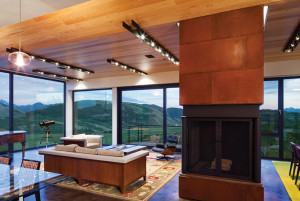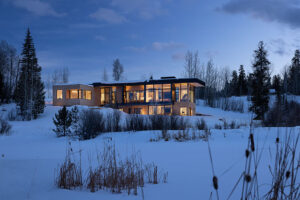In search of the perfect pre- and post-Valentine’s evenings out? Just mix art, atmosphere, music, and dining TONIGHT and next week at the National Museum of Wildlife Art. What’s not to love? Event details are below:
Mix’d Media This Evening!Locals and visitors alike will enjoy an African safari experience in the heart of Jackson Hole with the National Museum of Wildlife Art’s February 13 installment of its popular second-Thursday-of-the-month evening Mix’d Media event. In addition to the opportunity to view the stunning, spare photographs of “Elegy: The African Photography of Nick Brandt 2001-2008” exhibition, which serves as a theme for the event, guests can dine and sip on East African-inspired food and gin and tonics – and try their hand at snipping cut paper silhouettes as the evening’s hands-on art activity. Screen Door Porch will provide live music accompaniment to the festivities. The event takes place from 6-9 p.m. on Thursday, February 13 at the museum. Cover charge is $5 for non-members, free for museum members.
The Mix’d Media event also provides the opportunity for attendees to preview the entries in Trophy Art: Fun Forms for All, all of which goes up for sale on a first-come, first-serve basis on February 22. We had a chance to view a selection of these new takes on traditional animal mounts ourselves. As no animals were harmed in their creation, the entries bridge a whimsical gap between representation and artistic interpretation. From a majestic moose antler taking flight in new form to a delicately hand-painted plaster skull, the trophies would all provide delightful additions to a residential or office wall.

“Deer Skull with Lily” by Jane Lavino is one of the mounts available for sale at the Trophy Art fundraiser.
Marvel at the selected trophies yourself:
With the tongue-in-cheek tagline “No animals died in the making of these mounts,” the National Museum of Wildlife Art will offer the public an opportunity to purchase unique wildlife-inspired “trophy art,” as well as learn how to decorate using the faux mounts and perhaps create their own “shed antler art” home furnishings from found pieces.
The museum’s new Trophy Art: Fun Forms for All fundraiser takes place February 22 from 11 a.m. – 2 p.m. with expert talks by interior designer Christy Fox, owner of Wilson Formal in Wilson, and artisan Kyle Anderson of Game Trail Gatherings in Jackson. To add to the fun, a hands-on art activity will be provided, and pizza by Caldera and desserts from Persephone Bakery will be available for tasting. Admission to the event is free and includes access to the Wapiti Gallery, Rising Sage Café and the Museum Shop (regular museum admission will be charged for entry to the rest of the museum galleries).
Having some fun with the misconception of some museum visitors that it displays wildlife taxidermy, the National Museum of Wildlife Art conceived its new Trophy Art fundraiser, soliciting wildlife trophy-inspired artworks from national, Jackson Hole area and even amateur artists. The works will be on display at the museum February 12 – March 15, and are available for sale on a first come, first served basis, beginning at the February 22 event. Proceeds benefit the National Museum of Wildlife Art’s youth education programs.
The schedule of events for the February 22 Trophy Art: Fun Forms for All, to be held in the museum’s Wapiti Gallery, is as follows:
11:30 a.m. – 12:30 p.m. Christy Fox, owner of Wilson Formal, a shop specializing in art and home design, will answer questions and talk with visitors individually on the topic of “Bringing Wildlife Home – Design with Trophy Art.” Fox is known for her expertise in integrating art, conservation and a deep connection to the Jackson Hole region into her interior and artistic designs.
12:30 – 1:30 p.m. Grown-ups get to channel their inner child with an art activity that allows them to create their own mini-mounts, using multiple mediums for a take-home “trophy.”
1:30 – 2:00 p.m. Kyle Anderson of Game Trail Gatherings will demonstrate how he creates “truly unique home furnishings that transcend the ordinary experience,” using raw materials collected from the wild. Anderson will bring examples of both local and exotic “shed antler art” for his creations.
A member of the Association of Art Museum Directors and the Museums West consortium and accredited by the American Association of Museums, the museum, officially designated the National Museum of Wildlife Art of the United States by an act of Congress in 2008, provides an exciting calendar of exhibitions from its permanent collection and changing exhibitions from around the globe. A complete schedule of exhibitions and events is available online at www.wildlifeart.org. The museum is also active on Facebook and on Twitter at @WildlifeArtJH.















